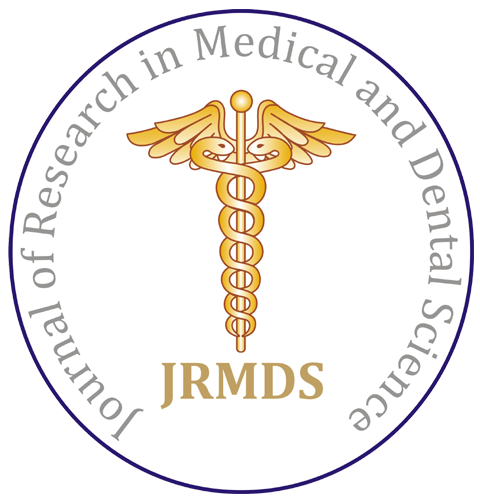Digital Impressions in Dentistry
Author(s): Aakanksha Mahesh Dalal*, Samruddhi Rathi and Mithelesh Dhamande
Abstract
Making impressions has always been an essential part of dentistry. Due to difficulties such as gagging, disagreeable taste,
and many others, it was formal accomplished with traditional impression materials such as alginate, agar-agar, and
elastomeric impressions. Digital impressions and digital scanners were among the latest methods. The entire way of taking
classical impressions that includes a lot of stages like tray selection, material blending trying to load, tray placing, and
withdrawal, has been excluded along the evolution of classical impressions, and the act of collecting smart impressions is
much faster and uncomplicated. So, in order to learn more about the digital impression, this force was chosen. We have
considered advantages and disadvantages of digitized impression techniques vs. conventional impression. The reliability of
digitized impressions in restorative dentistry is determined by a number of factors. The accuracy of digital imprints in
restorative dentistry may be influenced by the depth/angulations of the implants, the operator's skill, the intra-oral scanner
employed, and environmental factors. The goal of this research was to see what factors could influence the reliability of
digital imprints in restorative dentistry. In dentistry, Intra Oral Scanners (IOSs) are utilized to capture optical transmission
impressions. The advancement of 3D technology, as well as the growing usage of IOSs in dental clinics, has required a review
of the integrity of intra-oral digitized impressions. In dentistry, Intra Oral Scanners (IOSs) are utilized to capture optical
transmission impressions. The advancement of 3D technology, as well as the growing usage of IOSs in dental clinics, has
required a review of the integrity of intra-oral digitized impressions. The outcomes of the various IOS systems were found to
be variable in the investigations. While the efficiency of IOS systems looks to be prospective and similar to traditional
approaches, they are not without faults.
https://www.mobafire.com/profile/marmaristeknekirala12-1120487?profilepage http://www.effecthub.com/user/3725743 http://hawkee.com/profile/4949273/ https://www.youmagine.com/marmaristeknekirala12/designs https://www.myminifactory.com/users/Marmaristeknekirala12 http://onlineboxing.net/jforum/user/editDone/250019.page http://qooh.me/Marmaristekne https://linktr.ee/marmaristeknekirala12 https://pubhtml5.com/homepage/rskea/ https://telegra.ph/Marmaristeknekirala12-09-05 https://www.diggerslist.com/64f721ff718d5/about https://allmyfaves.com/Marmaristeknekirala12 https://www.metal-archives.com/users/Marmaristeknekirala12 https://www.catchafire.org/profiles/2490257/ https://www.fimfiction.net/user/633629/Marmaristeknekirala12 https://www.hebergementweb.org/members/marmaristeknekirala12.548722/ https://www.sqlservercentral.com/forums/user/marmaristeknekirala12 https://www.twitch.tv/marmaristeknekirala12/about https://www.roleplaygateway.com/member/Marmaristeknekirala12/ https://ko-fi.com/marmaristeknekirala12#paypalModal https://www.provenexpert.com/marmaristeknekirala12/ https://www.intensedebate.com/people/marmaristekne https://www.indiegogo.com/individuals/35150686 https://visual.ly/users/marmaristeknekirala/portfolio https://slides.com/marmaristeknekirala12 https://letterboxd.com/marmaristekne/ https://micro.blog/Marmaristeknekirala https://fliphtml5.com/dashboard/public-profile/pudlf https://community.windy.com/user/marmaristekne https://speakerdeck.com/marmaristeknekirala12 https://trello.com/u/marmaristeknekirala/activity https://www.redbubble.com/people/Marmaristekne/shop?asc=u https://myanimelist.net/profile/Marmaristekne https://3dwarehouse.sketchup.com/user/12639f7f-92aa-411b-a067-e7deea565fbf/Marmaristeknekirala12-M https://www.wattpad.com/user/Marmaristekne https://www.goodreads.com/user/show/169647299-marmaristeknekirala12 https://sourceforge.net/u/marmaristekne/profile https://tr.gravatar.com/marmaristeknekirala https://tr.pinterest.com/marmaristeknekirala/ https://www.mapleprimes.com/users/Marmaristeknekirala12 https://medium.com/@marmaristeknekirala https://www.ted.com/profiles/44959924 https://www.infragistics.com/community/members/d358780bec8a5f20d6f4563b7fd9e569ff4f3a39?_ga=2.74596625.2087551855.1693994141-821832157.1693994141 https://www.metooo.io/u/64f84eca6d5e6b4d2dc9d465 https://app.roll20.net/users/12383781/marmaristeknekirala12-m https://list.ly/marmaristeknekirala/newsfeed https://giphy.com/channel/Marmaristeknekirala12 https://www.tumblr.com/marmaristeknekirala12 https://dzone.com/users/4989214/marmaristeknekirala12.html https://www.creativelive.com/student/marmaristeknekirala12-marmaristeknekirala12?via=accounts-freeform_2 https://gab.com/Marmaristeknekirala12 https://sketchfab.com/Marmaristeknekirala12 https://www.flickr.com/people/httpsmarmaristeknekiralacomtr/ https://hub.docker.com/u/marmaristeknekirala12 https://forums.autodesk.com/t5/user/viewprofilepage/user/self https://mastodon.online/@Marmaristeknekirala12 https://wefunder.com/marmaristeknekirala12 https://calis.delfi.lv/profils/ https://os.mbed.com/users/marmaristeknekirala1/ https://notionpress.com/author/921940# https://guides.co/a/marmaristeknekirala12-marmaristeknekirala12/ https://www.bahamaslocal.com/userprofile/1/239817/Marmaristeknekirala12.html http://molbiol.ru/forums/index.php?showuser=1296710 https://www.credly.com/users/marmaristeknekirala12-marmaristeknekirala12/badges https://www.facer.io/user/irCYaMEYX0 https://www.mobafire.com/profile/marmarishome12-1119055?profilepage https://www.wishlistr.com/profile/ http://www.effecthub.com/user/3724210 http://hawkee.com/profile/4884005/ https://www.youmagine.com/marmarishome/designs https://www.myminifactory.com/users/marmarishome12 http://onlineboxing.net/jforum/user/edit/248549.page http://qooh.me/account/home/ https://band.us/band/92152039 https://linktr.ee/marmarishome12 https://pubhtml5.com/homepage/iprhm/ https://telegra.ph/marmarishome12-08-24 https://www.diggerslist.com/64e719eb6d769/about https://www.facer.io/user/WJmAjPpNr9 https://allmyfaves.com/marmarishome12 https://www.metal-archives.com/users/marmarishome12 https://www.catchafire.org/profiles/2479894/ https://www.fimfiction.net/user/630254/marmarishome12 https://www.hebergementweb.org/members/marmarishome12.542713/ https://www.sqlservercentral.com/forums/user/marmarishome12 https://www.twitch.tv/marmarishome12/about https://www.roleplaygateway.com/member/marmarishome12/ https://ko-fi.com/marmarishome12 https://www.provenexpert.com/marmarishome12/ https://www.intensedebate.com/people/marmarishome12 https://www.indiegogo.com/individuals/35056645 https://visual.ly/users/marmarishome/portfolio https://slides.com/marmarishome12 https://letterboxd.com/marmarishome12/ https://micro.blog/marmarishome12 https://fliphtml5.com/dashboard/publications https://community.windy.com/user/marmarishome12 https://www.longisland.com/profile/marmarishome12 https://speakerdeck.com/marmarishome12 https://trello.com/u/marmarishome/activity https://www.redbubble.com/people/marmarishome12 https://disqus.com/by/marmarishome12/about/ https://myanimelist.net/profile/marmarishome12 https://3dwarehouse.sketchup.com/user/c6ed99ef-400c-4a3d-af93-11bfcb2be913/marmarishome12-M https://www.wattpad.com/user/marmarishome12 https://www.goodreads.com/user/show/169358554-marmarishome12 https://sourceforge.net/u/marmarishome12/profile https://en.gravatar.com/marmarishomee4e8b75111 https://tr.pinterest.com/marmarishome/ https://www.mapleprimes.com/users/marmarishome12 https://medium.com/@marmarishome https://www.ted.com/profiles/44878861 https://www.infragistics.com/community/members/5d36dfb4d9fe1a193a81f1559de3c43d20e17704 https://marmarishome12.livejournal.com/profile https://www.metooo.io/u/64ec674f6d5e6b4d2dc02b90 https://hubpages.com/@marmarishome12 https://app.roll20.net/users/12349873/marmarishome12-m https://list.ly/marmarishome/ https://giphy.com/channel/marmarishome12 https://www.tumblr.com/blog/marmarishome https://dzone.com/users/4984261/marmarishome12.html https://www.creativelive.com/student/marmarishome12-marmarishome12?via=accounts-freeform_2 https://gab.com/marmarishome12 https://sketchfab.com/marmarishome12 https://www.flickr.com/people/199033566@N03/ https://devpost.com/marmarishome https://hub.docker.com/u/marmarishome12 https://forums.autodesk.com/t5/user/viewprofilepage/user/self https://profiles.wordpress.org/marmarishome12/ https://mastodon.online/@marmarishome12 https://wefunder.com/marmarishome https://seedandspark.com/user/marmarishome12 https://calis.delfi.lv/profils/lietotajs/311777-marmarishome12/ https://os.mbed.com/users/marmarishome12/ https://notionpress.com/author/918713# https://my.desktopnexus.com/marmarishome12/#ProfileComments https://guides.co/a/marmarishome12-marmarishome12/ https://www.bahamaslocal.com/userprofile/1/237330/marmarishome12.html http://molbiol.ru/forums/index.php?showuser=1295383 https://www.credly.com/users/marmarishome12-marmarishome12/badges https://orcid.org/0009-0009-4483-3745 https://www.mobafire.com/profile/marmarisboatcharter12-1124453?profilepage https://www.youmagine.com/marmarisboatcharter12/designs https://www.myminifactory.com/users/Marmarisboatcharter12 http://qooh.me/MarmarisSS https://linktr.ee/marmarisboatcharter12 https://pubhtml5.com/homepage/pdrml/ https://telegra.ph/Marmarisboatcharter12-10-06 https://www.diggerslist.com/651fbb00ae0f3/about https://allmyfaves.com/Marmarisboatcharter12 https://www.metal-archives.com/users/Marmarisboatcharter12 https://www.catchafire.org/profiles/2517163/ https://www.fimfiction.net/user/643467/Marmarisboatcharter12 https://www.hebergementweb.org/members/marmarisboatcharter12.562475/ https://www.sqlservercentral.com/forums/user/marmarisboatcharter12 https://www.twitch.tv/marmarisboatcharter12/about https://www.roleplaygateway.com/member/Marmarisboatcharter12/ https://www.provenexpert.com/marmarisboatcharter12/?mode=preview https://www.intensedebate.com/people/Marmarisboat https://www.indiegogo.com/individuals/35445398 https://visual.ly/users/marmarisboatcharter/portfolio https://slides.com/marmarisboatcharter12 https://letterboxd.com/marmarisboatcha/ https://fliphtml5.com/dashboard/public-profile/sfskb https://community.windy.com/user/marmarisboat https://speakerdeck.com/marmarisboatcharter12 https://trello.com/u/marmarisboatcharter https://myanimelist.net/profile/Besthairtranss https://3dwarehouse.sketchup.com/user/5acb3c60-4aca-43fd-91da-6bd442fd2ca0/Marmarisboatcharter12-M https://www.wattpad.com/user/Marmarisboat https://www.goodreads.com/user/show/170488799-marmarisboatcharter12 https://gravatar.com/marmarisboatcharterc48f3b5147 https://tr.pinterest.com/besthairtransplant12/ https://www.mapleprimes.com/users/Marmarisboatcharter12 https://medium.com/@marmarisboatcharter https://www.ted.com/profiles/45229026 https://www.infragistics.com/community/members/478be3bd644f2f8748f42767e5de46f150b1c783?_ga=2.233792990.1346871303.1696583692-28579674.1696583692 https://www.metooo.io/u/651fd08c119b751a01cd570d https://app.roll20.net/users/12503055/marmarisboatcharter12-m https://list.ly/marmarisboatcharter/activity https://giphy.com/channel/Marmarisboatcharter12 https://www.tumblr.com/marmarisboatcharter12 https://www.creativelive.com/student/marmarisboatcharter12?via=accounts-freeform_2 https://gab.com/Marmarisboatcharter12 https://www.flickr.com/people/199297576@N06/ https://seedandspark.com/user/marmarisboatcharter12-01hc2f7yr1a08wjenetgcj2pw4 https://os.mbed.com/users/marmarisboatcharter1/ https://calis.delfi.lv/blogs/lietotajs/317879-marmarisboatcharter12/ https://notionpress.com/author/933488 https://my.desktopnexus.com/Marmarisboatcharter12/ https://guides.co/a/marmarisboatcharter12-marmarisboatcharter12/ https://www.bahamaslocal.com/userprofile/1/249936/Marmarisboatcharter12.html http://molbiol.ru/forums/index.php?showuser=1302210 https://www.credly.com/users/marmarisboatcharter12-marmarisboatcharter12/badges https://ko-fi.com/marmarisboatcharter12#paypalModal https://devpost.com/marmarisboatcharter?ref_content=user-portfolio&ref_feature=portfolio&ref_medium=global-nav https://www.redbubble.com/people/Marmarisboat/shop?asc=u https://hub.docker.com/u/marmarisboatcharter12 http://onlineboxing.net/jforum/user/editDone/254192.page https://micro.blog/Marmarisboat http://www.effecthub.com/user/3729468 http://hawkee.com/profile/5136037/ https://wefunder.com/marmarisboatcharter12 https://www.facer.io/user/4s2M4eDMJM https://mastodon.online/@Marmarisboatcharter12 https://sketchfab.com/Marmarisboatcharter12 https://profiles.wordpress.org/marmarisboatcharter12/ https://dzone.com/users/5002505/marmarisboatcharter12.html
